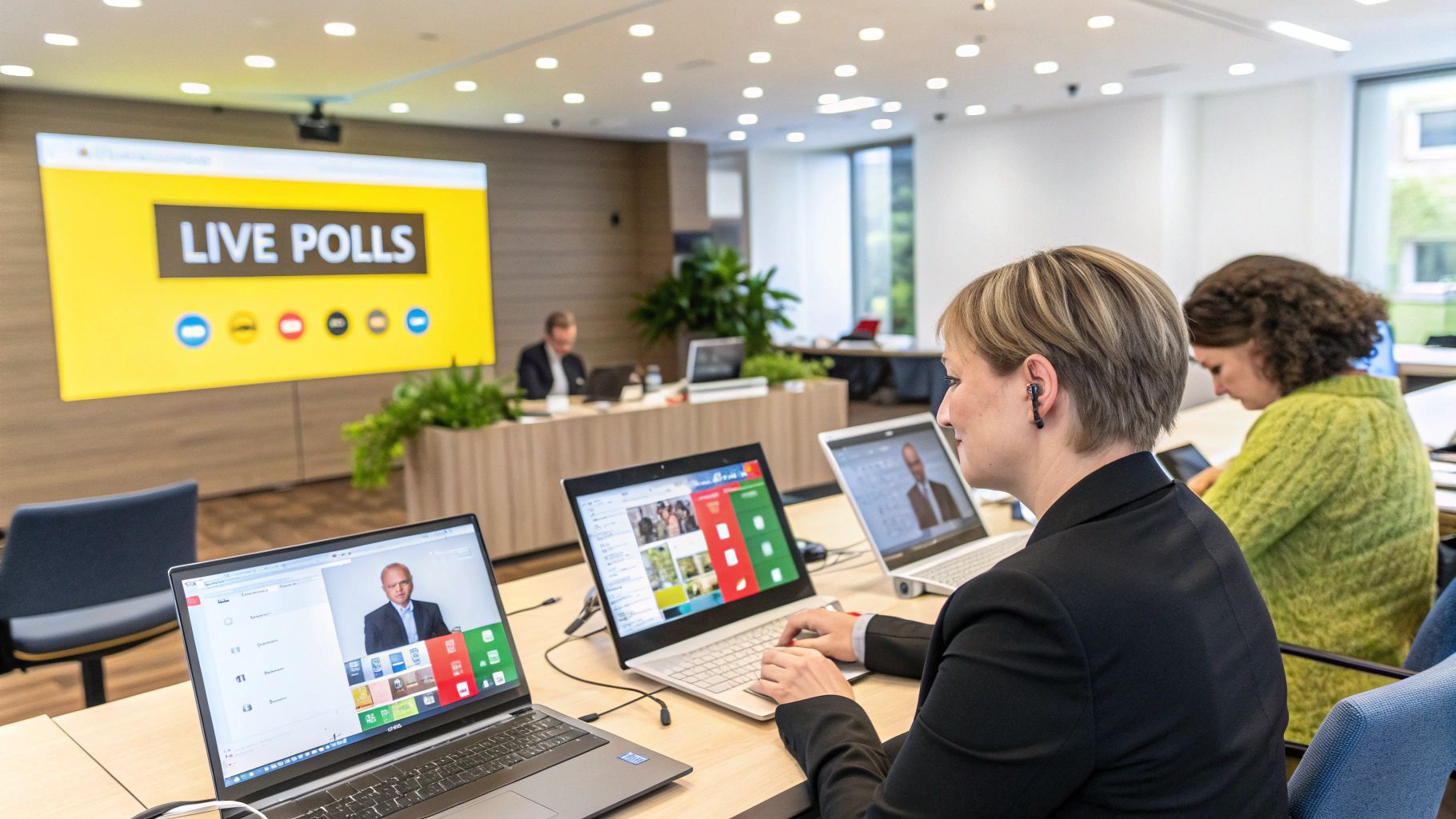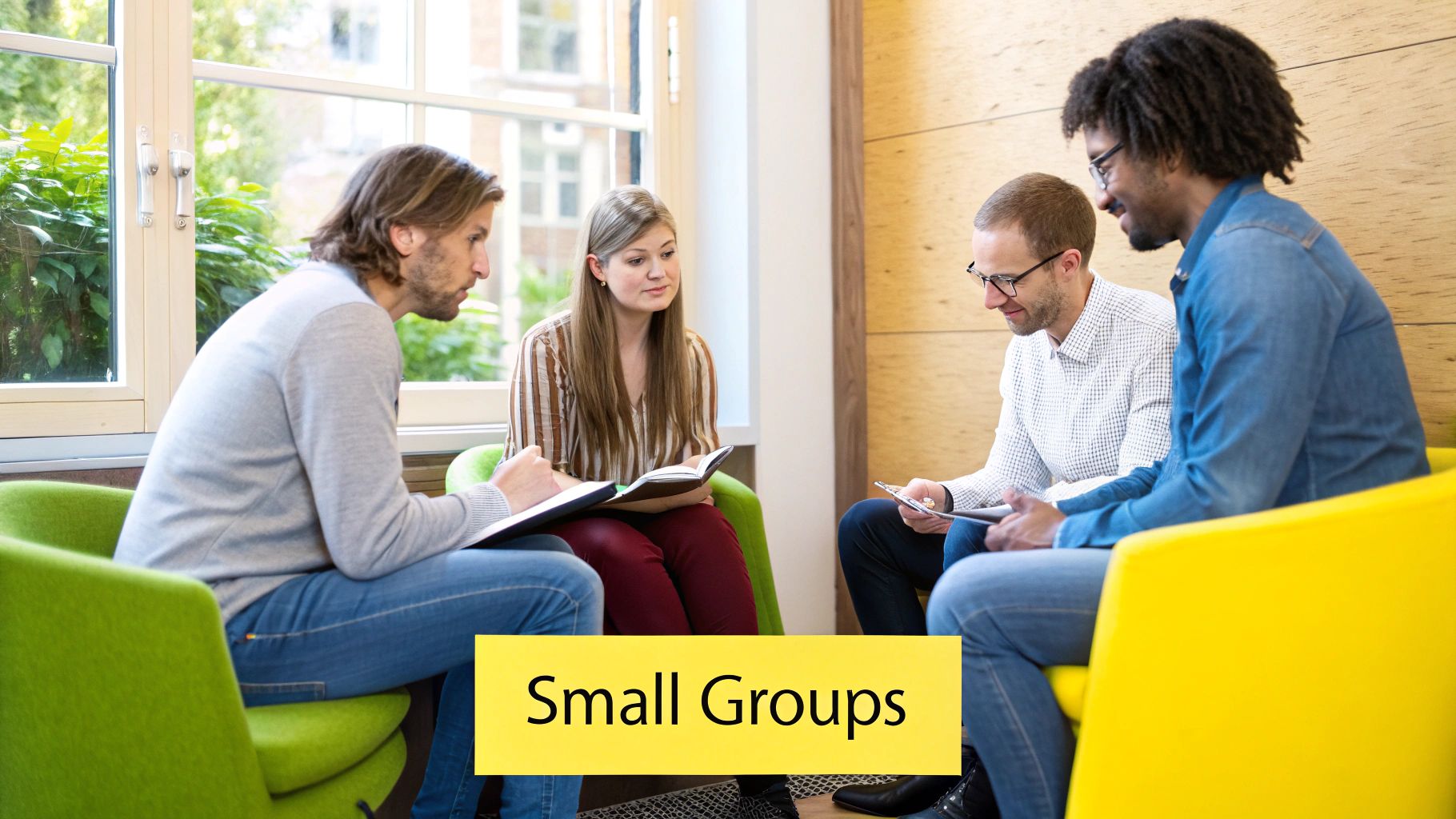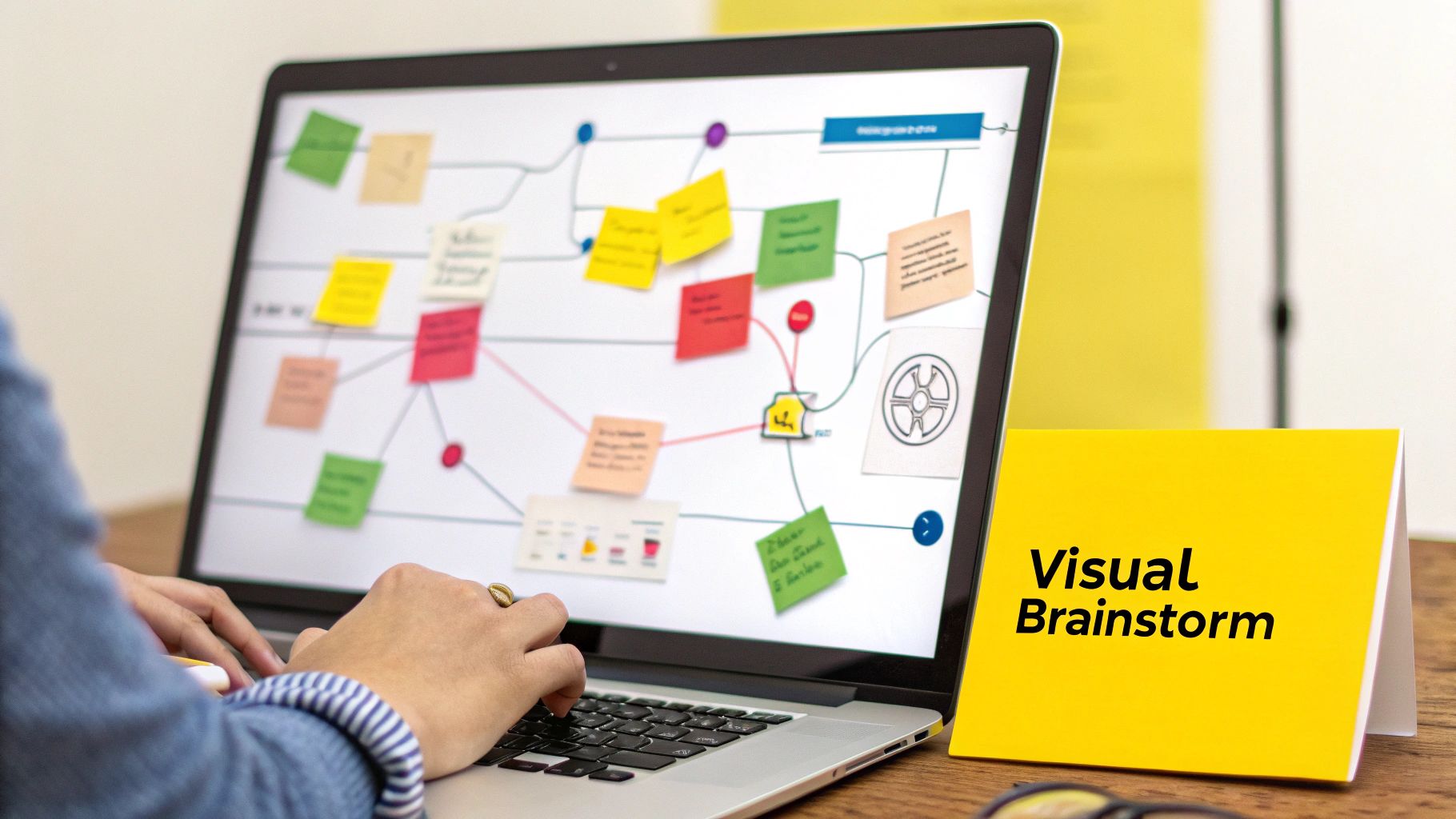Stop Wasting Time in Meetings: Unleash Engagement!
Tired of unproductive meetings? You’re not alone. Meetings are essential for collaboration, but they can quickly become time-wasters if not properly managed. This listicle offers ten innovative meeting engagement ideas to revitalize your team’s meetings and boost productivity. These actionable strategies will help transform dull gatherings into dynamic, productive sessions, ensuring your team leaves feeling energized and informed.
We’ll explore practical techniques like incorporating interactive polls and live Q&A sessions to encourage real-time feedback. Discover the power of breakout room discussions to foster focused conversations and generate innovative ideas. Learn how gamification elements can inject a sense of fun and competition into your meetings, while visual collaboration tools enhance understanding and engagement.
This listicle also delves into strategies like rotating meeting roles to distribute responsibility and promote active participation. Explore the use of energizer activities and icebreakers to create a positive atmosphere and encourage interaction. We’ll also look at innovative approaches like story-based content delivery and multi-sensory experiences to make your meetings memorable and impactful. Finally, we’ll examine reverse or unconventional meeting formats and the integration of technology, including AR/VR elements, to revolutionize your meeting experience.
Looking for specific examples of how to implement these meeting engagement ideas? Each item offers actionable advice tailored for Scrum Masters, Agile Coaches, software development teams, and other collaborative groups. We’ll show you how these practical strategies can improve information retention, foster team cohesion, and ultimately, make your meetings more effective. Let’s dive into these innovative approaches to revitalize your meetings and make them worth everyone’s time.
1. Interactive Polls and Live Q&A
Transform passive listeners into active participants with interactive polls and live Q&A sessions. These tools empower attendees to share immediate feedback, contribute opinions, and voice concerns in real-time, fostering a more dynamic and engaging meeting environment. This approach is particularly valuable for gathering quick insights, making collaborative decisions, and ensuring everyone feels heard.

Companies like Microsoft and Salesforce have successfully integrated these tools into their meeting workflows. Microsoft uses Mentimeter for sentiment tracking during all-hands meetings, while Salesforce leverages live polls in quarterly business reviews. Even universities enhance large lectures with platforms like Poll Everywhere. To ensure everyone is engaged, it’s important to ensure that meetings are productive and use everyone’s time wisely, which can boost team productivity. Learn more about how to efficiently Produktivität steigern. This active participation ensures that valuable time isn’t wasted and that everyone contributes meaningfully, ultimately leading to greater productivity and more effective outcomes. You can also learn more about effective sprint review meeting structures that incorporate these techniques.
Tips for Effective Implementation:
- Test your tech: Run a trial run before the meeting to avoid technical glitches and delays.
- Limit polls: Keep polls to 2-3 per meeting to maintain flow and avoid survey fatigue.
- Share results: Display poll results immediately to sustain momentum and spark further discussion.
- Prepare backups: Have backup questions or discussion prompts ready if participation is low.
- Anonymous options: Offer anonymous polling for sensitive topics to encourage open and honest feedback.
This meeting engagement idea earns its spot on this list because it directly addresses the challenge of passive listening. By giving every attendee a voice, even in large gatherings, these tools create a two-way communication channel that boosts engagement and facilitates richer discussions, ultimately leading to more productive meetings. Popular platforms include Mentimeter, Poll Everywhere, Slido, and Kahoot for business.
2. Breakout Room Discussions
Breakout room discussions transform large, often passive meetings into smaller, dynamic group interactions. By dividing participants into smaller groups for focused conversations, you leverage the psychological principle that individuals are more comfortable contributing in more intimate settings. This fosters active participation and encourages a wider range of perspectives to be shared. This approach is particularly valuable for brainstorming, problem-solving, and in-depth discussions.

Companies like Google utilize breakout formats for project discussions, and agile retrospective meetings frequently employ breakout sessions to gather individual feedback effectively. Even Harvard Business School leverages this technique in case study discussions. You can learn more about effective breakout room discussions within the context of workshop facilitation training.
Tips for Effective Implementation:
- Clear Objectives: Provide concise discussion prompts and clearly defined objectives for each group.
- Assigned Roles: Designate roles within each group, such as a timekeeper, note-taker, and presenter, to ensure structure and focused discussion.
- Time Management: Set specific time limits for breakout sessions and adhere to them strictly to maintain overall meeting efficiency.
- Diverse Groups: Strategically mix up group compositions to encourage interaction between individuals with different perspectives and expertise.
- Active Monitoring: Briefly visit each breakout room during discussions to offer support, ensure groups stay on track, and address any questions or roadblocks.
This meeting engagement idea effectively counters the common challenge of disengagement in large group settings. By fostering focused discussions in smaller groups, breakout rooms encourage active participation, facilitate richer dialogue, and ultimately lead to more productive meetings. Platforms like Zoom and Microsoft Teams offer integrated breakout room functionalities, streamlining the process and making it easily accessible for virtual teams.
3. Gamification Elements
Transform mundane meetings into engaging experiences by incorporating game-like elements. Points, badges, leaderboards, and challenges can tap into competitive instincts and achievement-oriented behavior, making meetings more dynamic and memorable. This approach boosts motivation and encourages active participation, turning passive attendees into enthusiastic contributors.

Companies like Deloitte and Microsoft have successfully integrated gamification into their training programs. Deloitte’s leadership training uses gamified elements to enhance learning, while Microsoft incorporates achievement systems in its internal training. Even sales teams at HubSpot and Duolingo’s internal meetings utilize gamified formats.
Tips for Effective Implementation:
- Align game elements: Ensure game mechanics align with meeting objectives.
- Simple scoring: Keep the scoring system simple and transparent.
- Varied challenges: Offer both individual and team-based challenges.
- Rotate formats: Regularly rotate game formats to maintain novelty and prevent staleness.
- Meaningful prizes: Ensure prizes or recognition are meaningful but avoid excessive competitiveness.
This meeting engagement idea earns a spot on this list because it directly addresses the challenge of maintaining enthusiasm and motivation in meetings. By introducing elements of fun and competition, gamification can transform routine gatherings into interactive and memorable experiences. This fosters a more positive and engaging meeting environment, promoting active participation and boosting overall productivity. Popular platforms include Kahoot, Mentimeter, and Classcraft for business.
4. Visual Collaboration Tools
Transform brainstorming sessions and project planning into dynamic, engaging experiences with visual collaboration tools. Digital whiteboards, mind mapping software, and collaborative visual platforms allow participants to contribute ideas simultaneously through drawings, sticky notes, diagrams, and multimedia content. This approach caters to visual learners and makes abstract concepts more tangible, fostering a shared understanding and boosting team cohesion.

Companies like IBM, Spotify, Netflix, and Airbnb have integrated visual collaboration tools into their workflows. IBM uses Miro for design thinking workshops, while Spotify employs Figma for product planning meetings. Netflix uses collaborative boards for content strategy sessions, and Airbnb utilizes visual tools for user experience mapping. Learn more about how to improve team collaboration using these tools: Learn more about how to improve team collaboration. This visual approach allows teams to work together effectively.
Tips for Effective Implementation:
- Provide brief tutorials: Offer short tutorials before the first use to ensure everyone is comfortable with the platform’s features.
- Use templates: Leverage templates to maintain structure and focus during brainstorming and planning sessions.
- Designate an organizer: Assign someone to organize and clean up the board to maintain clarity and avoid visual clutter.
- Set clear guidelines: Establish guidelines for contribution formats (e.g., text size, color-coding) for consistency.
- Save and share: Save and share board contents after meetings to document progress and facilitate asynchronous collaboration.
This meeting engagement idea deserves a spot on this list because it transforms passive observation into active participation. By providing a shared visual space, these tools encourage everyone to contribute ideas, regardless of their communication style. This collaborative approach fosters a sense of ownership and shared understanding, leading to more productive and engaging meeting experiences. Popular platforms include Miro, Mural, Figma, Microsoft Whiteboard, and Conceptboard.
5. Rotating Meeting Roles
Transform your meetings from passive observation to active participation with rotating meeting roles. This approach systematically assigns different responsibilities – such as facilitator, timekeeper, note-taker, devil’s advocate, and summarizer – to various team members across different meetings. Rotating roles distributes responsibility, develops leadership skills, and keeps meetings fresh with different facilitation styles, boosting meeting engagement ideas.
Agile Scrum teams often rotate Scrum Master responsibilities, embodying this principle. Companies like Buffer rotate meeting facilitation among all team members. Even Patagonia utilizes rotating roles in their sustainability committee meetings, demonstrating its applicability across diverse organizations. Non-profit boards also frequently implement rotating leadership roles.
Tips for Effective Implementation:
- Provide clear role descriptions: Outline expectations for each role to ensure clarity.
- Start with volunteers: Encourage initial participation through a volunteer basis before mandating rotations.
- Offer support: Provide coaching and support, especially for new facilitators.
- Create cheat sheets: Develop role-specific cheat sheets and templates as helpful resources.
- Gather feedback: Continuously improve role definitions by gathering regular feedback from participants.
This meeting engagement idea earns its place on this list because it directly combats meeting monotony and disengagement. By distributing ownership and empowering team members, rotating roles fosters a sense of shared responsibility and encourages active contribution. This ultimately leads to more dynamic and productive meetings. This approach is particularly valuable for teams seeking to improve collaboration, develop leadership skills, and foster a more inclusive meeting environment.
6. Energizer Activities and Icebreakers
Energizer activities and icebreakers are short, purposeful activities designed to revitalize meeting participants, sharpen focus, and foster connection. These can range from quick physical movements or stretches to creative thinking exercises and problem-solving games. By incorporating these activities, teams can reset their attention and build rapport before diving into the core meeting content. This creates a more positive and collaborative environment, leading to more productive discussions and better outcomes.
Companies like Google and Zappos have recognized the value of these short bursts of energy. Google encourages “2-minute mindfulness” exercises at the start of meetings, while Zappos incorporates creative icebreakers into team meetings. Even in virtual settings, teams at Microsoft often begin meetings with a round of virtual background sharing. Consulting firms frequently use energizers between intensive work sessions to maintain momentum and prevent burnout. Learn more about Energizer Activities and Icebreakers and how they can enhance your retrospective meetings.
Tips for Effective Implementation:
- Match the energy level: Select activities appropriate for the meeting time, purpose, and overall atmosphere. A quick stretch might be perfect for a morning meeting, while a more involved game could suit a team-building session.
- Inclusivity and accessibility: Ensure activities are inclusive and accessible to all participants, considering physical limitations or cultural differences.
- Backup plan: Have a few backup activities prepared in case one doesn’t resonate with the group or falls flat.
- Lead by example: As a facilitator, model enthusiasm and participation to encourage others to engage fully.
- Consider your team: Keep cultural and personality differences in mind when choosing activities to create a comfortable and engaging experience for everyone.
This meeting engagement idea is essential because it directly addresses common meeting pitfalls like low energy and disconnection. By injecting moments of fun and interaction, energizers and icebreakers transform passive attendees into active participants. This creates a more dynamic and collaborative atmosphere, contributing to a more enjoyable and productive meeting experience.
7. Story-Based Content Delivery
Transform dry meeting content into captivating narratives. Story-based content delivery structures information around case studies, personal anecdotes, and relatable scenarios, rather than traditional bullet points. This approach leverages the brain’s natural affinity for stories, making information more memorable and emotionally engaging. Instead of simply presenting facts, you connect with your audience on a deeper level, fostering understanding and buy-in.
Companies like Southwest Airlines weave customer stories into operational meetings to highlight service excellence. Airbnb shares host and guest stories in product development discussions to ensure user-centric design. Even Patagonia uses environmental impact stories in corporate communications to underscore their mission. TED Talks, known for their engaging presentations, consistently leverage this story-based format to connect with audiences worldwide.
Tips for Effective Implementation:
- Use real examples: Ground your stories in real-world scenarios and case studies for maximum impact.
- Sensory details: Include vivid descriptions and sensory details to make your stories come alive.
- Connect to objectives: Ensure stories directly relate to meeting objectives and key takeaways.
- Encourage sharing: Invite participants to share their own relevant stories to build connection and engagement.
- Practice delivery: Rehearse your stories to ensure a natural and confident presentation.
This meeting engagement idea earns its place on this list because it transforms passive listeners into active participants. By tapping into the power of narrative, story-based content delivery enhances comprehension, fosters emotional connection, and makes information stick. This leads to more productive meetings where ideas resonate and inspire action.
8. Multi-Sensory Meeting Experiences
Transform your meetings from passive listening sessions to immersive experiences by engaging multiple senses. Beyond the usual sight and sound, consider incorporating tactile materials, aromatherapy, background music, flavored beverages, and textured objects. This approach recognizes that people process information differently and that sensory variety can enhance focus and memory, leading to more productive meetings. To make your content more engaging, you can also improve storytelling skills.
Google offices are known for their sensory-rich meeting environments, demonstrating the power of this approach. Design thinking workshops frequently incorporate hands-on materials to encourage creative problem-solving. Even therapy and wellness organizations leverage the calming effects of aromatherapy in meetings. Creative agencies often find inspiration through music and textures in brainstorming sessions.
Tips for Effective Implementation:
- Sensitivity Check: Survey your team for any allergies or sensitivities before introducing sensory elements.
- Start Small: Begin with subtle additions like background music or a single aromatherapy diffuser and gauge the team’s response.
- Purposeful Sensory Design: Align sensory elements with your meeting goals. Upbeat music and bright colors can energize a brainstorming session, while calming scents and soft lighting create a more relaxed atmosphere for reflective discussions.
- Optional Participation: Provide options rather than forcing participation to respect individual preferences.
- Keep it Simple: Avoid overwhelming the senses. Sensory elements should enhance, not distract from, the meeting’s purpose.
This meeting engagement idea stands out because it acknowledges the diverse ways people learn and engage. By catering to different sensory preferences, you can create a more inclusive and stimulating meeting environment. This ultimately fosters deeper engagement, improves information retention, and sparks more creative thinking. This approach can significantly enhance meeting engagement ideas and ensure everyone contributes meaningfully.
9. Reverse or Unconventional Meeting Formats
Shake up the traditional meeting structure with reverse or unconventional formats. This involves flipping the script by having participants consume content beforehand (like in a flipped meeting), starting with conclusions and working backward, or even embracing “meeting-free meetings” where objectives are achieved through alternative methods. This approach empowers attendees to arrive prepared, fostering more focused and productive discussions.
Companies like Basecamp champion meeting-alternative communication methods, demonstrating the effectiveness of asynchronous work. Many tech companies utilize asynchronous decision-making processes, while consulting firms often assign “client homework” before strategy sessions. Even educational institutions like Harvard Business School embrace the flipped classroom methodology, a testament to the power of pre-meeting preparation. Learn more about engaging virtual teams and alternative meeting structures in diverse settings at this informative resource.
Tips for Effective Implementation:
- Communicate clearly: Explicitly outline the new format expectations well in advance.
- Engaging content: Provide pre-meeting materials that are easy to digest and engaging.
- Backup plan: Have alternatives for participants who didn’t have time to prepare.
- Start small: Test new formats with low-stakes meetings before implementing them widely.
- Gather feedback: Solicit feedback and adjust the format based on participant input.
This approach earns a spot on our list because it directly addresses common meeting pain points like unproductive discussions and wasted time. By rethinking the traditional meeting structure, teams can foster a more engaged and productive environment. These unconventional approaches maximize valuable time and ensure everyone contributes meaningfully, ultimately leading to more efficient meetings and better outcomes.
10. Technology Integration and AR/VR Elements
Transform your meetings from static presentations to dynamic, interactive experiences by incorporating cutting-edge technologies. Augmented reality (AR), virtual reality (VR), and AI-powered tools can create engaging meeting environments that transcend traditional physical and digital boundaries. These immersive experiences foster deeper collaboration, enhance understanding, and boost overall meeting engagement.
Companies like Walmart and Ford are already leveraging these technologies. Walmart uses VR for employee training, while Ford employs it for design collaboration. Microsoft utilizes its HoloLens for architectural planning, and Meta (formerly Facebook) promotes VR meetings via Horizon Workrooms. Even Boeing has integrated AR into its maintenance training sessions. These real-world examples demonstrate the transformative power of technology in meeting environments.
Tips for Effective Implementation:
- Start small: Begin with simple technology integrations before investing in complex systems.
- Training is key: Provide adequate training and support for any new technologies introduced.
- Backup plans: Always have low-tech backup plans in case of technical failures.
- Value over novelty: Focus on technologies that genuinely add value, not just for the sake of novelty.
- Accessibility: Consider accessibility and inclusion for all participants when selecting technologies.
This meeting engagement idea merits inclusion because it pushes the boundaries of traditional meetings. By leveraging AR/VR and AI, teams can experience information in new and engaging ways. This fosters a more interactive and immersive environment, improving comprehension, collaboration, and overall meeting effectiveness. These cutting-edge tools offer a glimpse into the future of meetings, promoting a more dynamic and productive experience for all involved.
Engagement Ideas Comparison Matrix
| Item | Implementation Complexity 🔄 | Resource Requirements ⚡ | Expected Outcomes 📊 | Ideal Use Cases 💡 | Key Advantages ⭐ |
|---|---|---|---|---|---|
| Interactive Polls and Live Q&A | Medium – needs tech setup and testing | Requires internet, polling software, devices | Increased engagement and immediate feedback | Meetings needing active participation and instant feedback | Encourages participation, real-time insights, data-driven decisions |
| Breakout Room Discussions | Medium – coordination and facilitation | Requires planning, virtual breakout tech | More intimate, diverse discussions | Large meetings needing focused group work | Promotes quieter member participation, deeper topic exploration |
| Gamification Elements | High – designing games and scoring | Ongoing content creation and game platforms | Boosted motivation and engagement | Training sessions, long meetings needing energy | Makes meetings enjoyable, clear engagement metrics |
| Visual Collaboration Tools | Medium – learning curve for tools | Collaborative software, internet, compatible devices | Visual idea sharing and creative problem-solving | Brainstorming, design thinking, visual-heavy topics | Supports all learning styles, simultaneous contributions |
| Rotating Meeting Roles | Low to Medium – role definitions needed | Minimal tech, requires training time | Leadership development and fresh facilitation | Teams building facilitation skills and ownership | Builds team skills, prevents monotony, creates egalitarian culture |
| Energizer Activities and Icebreakers | Low – simple activities | Little to no resources needed | Increased energy and social connection | Short meetings needing energy boosts | Quick energy boosts, team building, mental reset |
| Story-Based Content Delivery | Medium – prep and storytelling skills | Minimal (presentation aids) | Better retention and emotional engagement | Presentations needing impact and memorability | Enhances recall, emotional connection, active listening |
| Multi-Sensory Meeting Experiences | Medium – preparation for sensory elements | Cost for materials, scents, and setup | Enhanced focus and memorable experiences | Creative or wellness-focused meetings | Accommodates sensory preferences, reduces fatigue |
| Reverse or Unconventional Meeting Formats | Medium – requires cultural shift | Pre-meeting materials, communication tools | Efficient use of meeting time | Meetings with information-heavy content | Maximizes synchronous time, deeper discussions |
| Technology Integration and AR/VR Elements | High – advanced tech and training | High cost equipment and support | Immersive, innovative collaboration | High-tech, remote, or training-heavy meetings | Highly engaging, visualizes complex data, innovative |
Elevate Your Meetings: Engagement is Key
This article explored ten powerful meeting engagement ideas designed to transform passive attendees into active participants. From leveraging interactive polls and breakout rooms to incorporating gamification and multi-sensory experiences, each strategy offers a unique approach to revitalizing your meetings. By focusing on creating dynamic and engaging experiences, you can foster a more collaborative and productive environment for your team.
Key Takeaways for Enhanced Engagement
Let’s recap the most impactful takeaways for boosting meeting engagement:
- Prioritize interaction: Methods like live Q&A sessions, breakout discussions, and visual collaboration tools empower participants to contribute actively. Consider rotating meeting roles to distribute responsibility and encourage ownership.
- Embrace creativity: Infuse your meetings with energy through gamification, story-based content delivery, and unconventional meeting formats. Experiment with energizer activities and icebreakers to break the ice and foster camaraderie.
- Leverage technology strategically: Integrate technology seamlessly to enhance the meeting experience. Explore AR/VR elements for immersive collaboration. When sharing digital resources, consider incorporating creative presentation elements. To further enhance the use of technology, consider incorporating creative elements such as unique QR code design to streamline access to supplementary materials or feedback forms. This simple touch can create a more modern, engaging feel. Source: How to design a qr code: Tips for Click-Worthy Codes from QR Star
Implementing Effective Meeting Engagement
Mastering these meeting engagement strategies translates directly into tangible benefits for your team:
- Increased productivity: Engaged participants are more focused and contribute more effectively, leading to quicker decision-making and faster progress.
- Improved team morale: Dynamic meetings foster a sense of community and shared purpose, boosting team morale and strengthening working relationships.
- Better outcomes: When team members are actively engaged, they are more likely to generate innovative ideas and contribute to achieving shared goals.
Remember that successful implementation requires adapting these ideas to your specific team’s needs and organizational culture. Experiment, gather feedback, and refine your approach to discover what resonates best with your team.
Transform Your Meetings with NASA
By embracing these engagement strategies, you can transform your meetings from routine obligations into valuable opportunities for connection, collaboration, and growth. Ready to streamline the implementation of these dynamic meeting engagement tactics? Explore resolution Reichert Network Solutions GmbH’s NASA (Not Another Standup App) platform. NASA provides a comprehensive solution designed to integrate seamlessly with these engagement ideas, facilitating agile meetings, boosting team participation, and driving better outcomes. Visit resolution Reichert Network Solutions GmbH to discover how NASA can revolutionize your team’s meeting experience.
